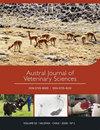马多灶性上皮汗腺癌的临床表现及治疗
IF 0.8
4区 农林科学
Q3 VETERINARY SCIENCES
引用次数: 1
摘要
. 马的上皮腺癌是一种非常罕见的皮肤肿瘤。本报告描述了一匹马,表现为多发结节,伴有伴有正常、脱发和溃疡的皮肤,通过组织病理学诊断为上皮腺癌。治疗包括联合手术切除,局部治疗溃疡结节和冷冻治疗非溃疡肿瘤。治疗6个月后,切除的肿瘤没有再生,25个接受冷冻治疗的小肿瘤中只有10个明显。本文章由计算机程序翻译,如有差异,请以英文原文为准。
Clinical presentation and treatment of multifocal epitrichial sweat gland carcinoma in a horse
. Epitrichial gland carcinoma is a very rare type of skin tumour in horses. This report describes a horse presenting multiple nodules with associated normal, alopecic and ulcerated skin diagnosed via histopathology as epitrichial gland carcinoma. Treatment consisted of combined surgical excision, topical therapy for ulcerated nodules and cryotherapy for non-ulcerated tumours. Six months following therapy, the excised masses had not regrown and only 10 out of 25 small tumours previously treated with cryotherapy were noticeable.
求助全文
通过发布文献求助,成功后即可免费获取论文全文。
去求助
来源期刊

Austral Journal of Veterinary Sciences
Veterinary-General Veterinary
CiteScore
1.60
自引率
0.00%
发文量
18
期刊介绍:
Austral Journal of Veterinary Sciences (formerly Archivos de Medicina Veterinaria) publishes original scientific contributions in English, containing the latest developments and discoveries in veterinary sciences. The journal covers topics such as animal health and production, preventive medicine, zoonosis, pharmacology and therapeutics, methods of diagnosis, and other areas related to the veterinary field.
Austral Journal of Veterinary Sciences aims to divulge information about advances in veterinary medicine among universities, research centres, industries, government agencies, biologists, agronomists and veterinarians.
 求助内容:
求助内容: 应助结果提醒方式:
应助结果提醒方式:


